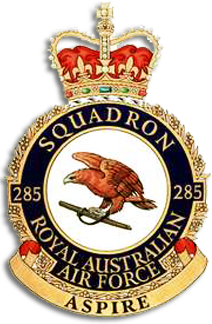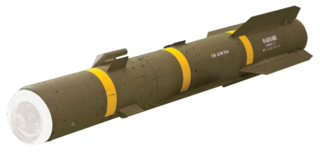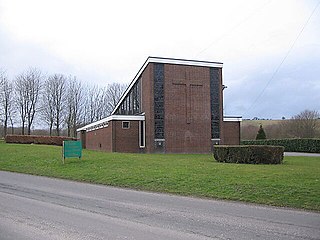Related Research Articles
The Lockheed Martin Corporation is an American aerospace and defense manufacturer with worldwide interests. It was formed by the merger of Lockheed Corporation with Martin Marietta in March 1995. It is headquartered in North Bethesda, Maryland. As of January 2022, Lockheed Martin employs approximately 115,000 employees worldwide, including about 60,000 engineers and scientists.

The M142 High Mobility Artillery Rocket System is a light multiple rocket launcher developed in the late 1990s for the United States Army and mounted on a standard U.S. Army Family of Medium Tactical Vehicles (FMTV) M1140 truck frame.

The MGM-140 Army Tactical Missile System is a supersonic tactical ballistic missile designed and manufactured by the US defense company Ling-Temco-Vought (LTV), and later Lockheed Martin through acquisitions.

The Royal Danish Air Force (RDAF) is the aerial warfare force of the Kingdom of Denmark and one of the four branches of the Danish Armed Forces. Initially being components of the Army and the Navy, it was made a separate service in 1950. Its main purpose is to serve as enforcer of Danish airspace and to provide air support to Danish group troops on the battlefield.

The Atomic Weapons Establishment (AWE) is a United Kingdom Ministry of Defence research facility responsible for the design, manufacture and support of warheads for the UK's nuclear weapons. It is the successor to the Atomic Weapons Research Establishment (AWRE) with its main site on the former RAF Aldermaston and has major facilities at Burghfield, Blacknest and RNAD Coulport.
The multiple integrated laser engagement system, or MILES, is used by the U.S. military and other armed forces around the world for training purposes. It uses lasers and blank cartridges to simulate actual battle.

The Royal Canadian Air Force is the air and space force of Canada. Its role is to "provide the Canadian Forces with relevant, responsive and effective airpower". The RCAF is one of three environmental commands within the unified Canadian Armed Forces. As of 2020, the Royal Canadian Air Force consists of 12,074 Regular Force and 1,969 Primary Reserve personnel, supported by 1,518 civilians, and operates 258 manned aircraft and nine unmanned aerial vehicles. Lieutenant-General Eric Kenny is the current Commander of the Royal Canadian Air Force and Chief of the Air Force Staff.

No. 285 Squadron was a Royal Australian Air Force (RAAF) training squadron. Controlled by No. 84 Wing, the squadron was formed in August 1999 to train the RAAF's Lockheed Martin C-130J Hercules aircrew and ground support staff. No. 285 Squadron did not control any flying aircraft but managed the flight simulator used for converting aircrew to the C-130Js operated by No. 37 Squadron. It was also allocated decommissioned Hercules airframes for training purposes, as well as flying aircraft from No. 37 Squadron when required. Throughout its existence, No. 285 Squadron was located at RAAF Base Richmond in the western suburbs of Sydney. The squadron was disbanded in December 2017.

The AGM-179 Joint Air-to-Ground Missile (JAGM) is an American military program to develop an air-to-surface missile, to replace the current air-launched BGM-71 TOW, AGM-114 Hellfire, and AGM-65 Maverick missiles. The U.S. Army, Navy, and Marine Corps plan to buy thousands of JAGMs.
A dynamic terrain is the representation of terrain together with the capability for modification during a simulation.

Lockheed Martin F-35 Lightning II procurement is the planned selection and purchase of the Lockheed Martin F-35 Lightning II, also known as the Joint Strike Fighter (JSF) by various countries.

The Joint Light Tactical Vehicle (JLTV), known and marketed under Oshkosh development as the L-ATV, is a light utility/combat multi-role vehicle. The Oshkosh-developed JLTV was selected for acquisition under the US military's Army-led Joint Light Tactical Vehicle program. In the very early stages of the program it was suggested that JLTV would replace the AM General High Mobility Multi-purpose Wheeled Vehicle (HMMWV) on a one-for-one basis. It is now suggested that the JLTV will partially replace the HMMWV.

The Ajax, formerly known as the Scout SV, is a group of armoured fighting vehicles being developed by General Dynamics UK for the British Army. It has suffered serious development and production difficulties.

The UK Military Flying Training System (UKMFTS) takes UK armed forces aircrew from initial training through elementary, basic, and advanced flying training phases, preparing them for their arrival at their designated operational aircraft units. It is operated by Ascent Flight Training, a consortium of Lockheed Martin and Babcock International under a 25-year Private Finance Initiative (PFI) contract for the UK's Ministry of Defence (MoD), with oversight from the MoD. The airworthiness authority for each aircraft type, for example, is fulfilled by military and civilian staff within Defence Equipment and Support. Apart from the overall contract, the main elements of the system include fixed-wing elementary, multi-engine and fast-jet pilot training, rear crew training and rotary-wing (helicopter) training.
Waterloo Lines is a British Army barracks on Imber Road in Warminster, Wiltshire, England. It is currently home to a number of Army specialist training schools and a sizeable portion of the Headquarters Field Army.

Warminster Garrison is a military garrison of the British Army, on the edge of Salisbury Plain in Wiltshire, England.
Harman Lines is a military installation of the British Army, which is part of Warminster Garrison on the Salisbury Plain. Harman Lines is on Sack Road in Warminster, Wiltshire, United Kingdom.
The New Medium Helicopter (NMH) is a British military programme to procure up to 44 medium-lift support helicopters to replace the Westland Puma HC2 and initially, the Bell 412 Griffin operated by the Royal Air Force; and the Bell 212 and Airbus AS365 Dauphin operated by the British Army. It is expected the new aircraft will enter service during the late-2020s. By the mid 2020s, only the Puma HC2 is intended for replacement, the other types have already been retired or will remain in service.
References
- ↑ "Lockheed Martin Receives Two-Year Combined Arms Tactical Trainer Interim Support Contract". Lockheed Martin. 15 May 2018. Archived from the original on 12 April 2021. Retrieved 13 October 2020.
- 1 2 "UK Combined Arms Tactical Trainer (UK CATT)". Lockheed Martin. Archived from the original on 17 March 2015. Retrieved 11 January 2015.
- ↑ Army Welfare Service (January 2011). "Service Community Official Guide: Warminster" (PDF). Method Publishing. p. 79. Archived from the original (PDF) on 9 November 2011.
- ↑ "Combined Arms Tactical Trainer (CATT)". Ministry of Defence. Defence Procurement Agency. 16 December 2005. Archived from the original on 1 February 2006.
- ↑ "Lockheed to continue support for UK Army's combined arms tactical trainer". Army Technology. 20 September 2015. Archived from the original on 1 October 2015. Retrieved 13 October 2020.
- ↑ "Combined Arms Tactical Trainer - Further info". Ministry of Defence. Defence Procurement Agency. 16 September 2005. Archived from the original on 1 February 2006.
- ↑ "Completion of CATT Building". Jordan & Faber. 20 March 2019. Archived from the original on 22 September 2020. Retrieved 13 October 2020.